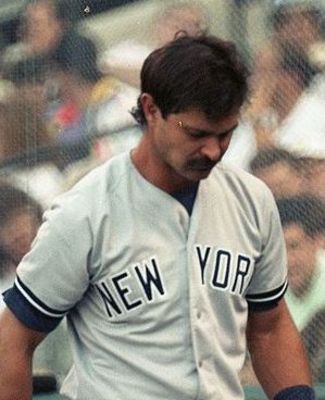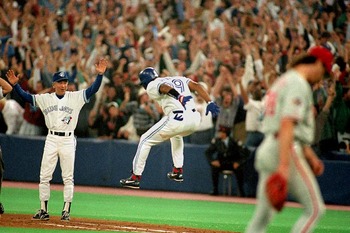Over at Baseball Think Factory, there's a link to and some discussion of a short piece at Banished to the Pen about trends in the usage of closers in the last 20 years or so. The writer asserts that while there is some downward trend in the amount of work each closer is doing, bullpen usage overall has not changed significantly in that span.
Even if front offices and field staffs want to begin using closers longer in games, the data suggests [sic] that pitchers are now conditioned to work three outs and rarely more. Because of that, the next step in reliever usage doesn’t appear to be calling on the Aroldis Chapmans of the world for more than one inning during the majority of the season.
Instead, the real sea change will happen when managers begin using their closers in the highest-leverage situations late in the game—regardless of conventional baseball thinking or contract incentives that reward saves.
While I agree with the first part of his final thoughts, I'm also wondering if perhaps the latter isn't already happening, but I'll get to that later. Right now I want to nit-pick about methodology.
Banished used the top 10 pitchers by Saves each year back to 1995, but this seems needlessly limiting and arbitrary to me. Besides the fact that the Save is kind of a stupid statistic for measuring pitcher effectiveness, the top 10 pitchers each year are not the only ones with the right to be called "Closers". Both very good and very bad teams can have closers that do not happen to end up in the top 10 in Saves, which are sometimes a result of happenstance and usage patterns more than talent. (Joe Borowski led the league with 45 Saves in 2007 despite an ERA of 5.07. Brad Lidge twice amassed 30+ Saves with an ERA over 5.00, once over 7!)
For example, in 1998, the "top-10 rule" would eliminate Ugueth Urbina, who was (among relievers) 5th in MLB with 3.2 bWAR that year, despite amassing "only" 34 Saves for the lowly Expos, and Mariano Rivera, who amassed only 36 Saves for the Greatest Baseball Team in History. Any of the best sportsbooks would have told you to put your money on the 1998 Yankees.
Or for a more recent example, using the top 10 rule for 2015 (actually 11, as there was a 3-way tie for 10th) you'd leave out Greg Holland, David Robertson, Aroldis Chapman, and Drew Storen, the last of which he uses for an example in his own article.
Therefore, I instead chose to set the benchmark at anyone with at least 25 Saves in a season, which gave me well over 400 data points for the 26 seasons, which I averaged by season to look for trends. Still an arbitrary benchmark, I'll admit, but one that gives us a more reasonable look at the pitchers would could reasonably be called mostly full time closers in the last two decades.
Or for a more recent example, using the top 10 rule for 2015 (actually 11, as there was a 3-way tie for 10th) you'd leave out Greg Holland, David Robertson, Aroldis Chapman, and Drew Storen, the last of which he uses for an example in his own article.
Therefore, I instead chose to set the benchmark at anyone with at least 25 Saves in a season, which gave me well over 400 data points for the 26 seasons, which I averaged by season to look for trends. Still an arbitrary benchmark, I'll admit, but one that gives us a more reasonable look at the pitchers would could reasonably be called mostly full time closers in the last two decades.
Here are the annual averages for pitchers with 25+ saves per year*:
Year IP IP/App %GF-25S %GF -Top10 1995 66.2 1.05 89% 91% 1996 68.7 1.05 88% 88% 1997 69.8 1.03 85% 88% 1998 70.1 1.05 86% 90% 1999 70.4 1.05 86% 89% 2000 70.6 1.06 87% 89% 2001 68.1 1.02 87% 89% 2002 70.8 1.06 88% 92% 2003 71.1 1.05 84% 87% 2004 73.2 1.06 86% 90% 2005 68.6 1.03 87% 88% 2006 67.8 1.04 85% 85% 2007 67.3 1.02 86% 88% 2008 63.3 0.99 84% 89% 2009 64.6 1.00 83% 86% 2010 63.4 1.00 86% 87% 2011 64.6 0.98 82% 86% 2012 66.5 0.99 79% 87% 2013 63.6 0.98 83% 87% 2014 64.7 1.00 82% 84% 2015 62.3 0.98 81% 86%
*For the strike-shortened 1995 season, I prorated the innings total for 162 games instead of 144.
These columns are, respectively, the averages for the innings pitched per season, the Innings per appearance, the percentage of games finished for the pitchers with at least 25 Saves, and the percentage of games finished for the top 10 Save leaders each year. Seems like there are some pretty notable trends here, but in case you're a more visual person...graphs!
While there was a downward trend in the data for the top-10 Saves closers, and there is one in my own data, the writer at Banished implies that "...closers throwing only six or seven fewer innings per season now," is somehow "not dramatic," a notion with which I respectfully dissent.
And you can see that this is also born out in the data. Pitchers used primarily as closers averaged only 62 1/3 IP in 2015, compared with somewhere between 69 and 71 IP in 1996-2003. (Somehow, 1995 still comes off as an anomaly, even with my data correction.) Then there was a peak of 73 IP in 2004, brought about by the fact that there were seven players with over 80IP that year, including Brad Lidge with almost 94. No other year had more than five such pitchers, and most years -including each year since 2005 - had only one or none at all.
All seven of those 80+ IP relievers were former starters, and as one of the other trends noted in the banished piece points out, with the tendency to groom closers even from college on to be closers, i.e. not to pitch more than 70 or so innings in a year, we may have seen the end of such groups.
But getting back to that downward trend in innings per appearance, that's about a 10% difference in their total innings. My data, because it includes some closers who may have lost their jobs or gained them during the season, necessarily shows a slightly less pronounced decline, about 8% lower in 2015 than at the peak in 2002 and 2004, but still, there is a difference.
But getting back to that downward trend in innings per appearance, that's about a 10% difference in their total innings. My data, because it includes some closers who may have lost their jobs or gained them during the season, necessarily shows a slightly less pronounced decline, about 8% lower in 2015 than at the peak in 2002 and 2004, but still, there is a difference.
If you said that a top position player was playing "only 10-15 games" less per year than was expected of him 20 years ago, and implied that this was somehow no big deal, it would be laughable. Likewise, if a starting pitcher averaged 20-25 fewer innings per year, and yet expected to be paid more money...OK, that's actually happening. Bad example.
But in any case, it does seem to me that this is not an insignificant change. His argument is that we are more likely to see a change in usage not in total innings, but in situational usage, and I'm not certain if we aren't already seeing that:
This chart shows how frequently these pitchers are used to finish games (i.e. the percentage of their appearances that are used to end games, not the percentage of the team's games they finish.) and is for pitchers with at least 25 Saves each year. However, the data in the table above also include the percentages for top 10-Saves closers, and you can see a slight downward trend there too, from 88-91% in the mid to late 1990's to only 84-86% now.
In short, it seems that closers are already not being used as exclusively to close games as they once were. Some of the differences in the numbers between the two data sets may be attributable to how a pitcher may be used differently, getting promoted or demoted from the Closer role in mid-season.
The 2012 data for example, mark the lowest percentage, just 79% of appearances to finish games, but these data are skewed significantly by two pitchers going in different directions:
- Santiago Casilla started the 2012 season as the Giants' closer but had five Losses and five Blown Saves by the end of July and lost his job to Sergio Romo.
- Tyler Clippard started the 2012 season as the main set-up guy in the Nationals' bullpen, but with Drew Storen injured and Brad Lidge washed-up and Henry Rodriguez wild and ineffective (14 walks and a 4.74 ERA in 19IP through May!) Clippard got promoted and stayed there.
My conclusion, for what it's worth, is that teams are already starting to do matchups in high leverage situations, often keeping two or more "closer-type" pitchers in the back of the bullpen, when possible, as the yankees have with Andrew Miller and Dellin Betances, or the Royals' famous three-headed monster of Holland/Davis/Hererra. There's probably a way to test that hypothesis, the preponderance of teams with two or more pitchers amassing 10+ Saves, or something like that, but I've crunched enough numbers for today.

















